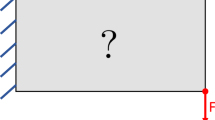Abstract
The FEM-based topology optimization repeats usually finite element analyses many times to converge to the stopping criteria. If the near-optimal topology data are available in advance at the beginning of an optimization process, the iterative computation could be greatly reduced. In an effort to obtain swiftly optimum topology solutions, the deep learning and neural networks with a special segmentation scheme of digital images are combined with the BESO (bi-directional evolutionary structural optimization) topology method in this study. The pre-trained digital images of 3200 optimum topologies construct the design domain for the main topology optimization. Additionally, a new post-processor is developed in order to reconstruct the relative locations among finite elements in the raw outputs generated by the neural network. The proposed method has been demonstrated to be efficient in lowering the iterations with several 2D and 3D optimization examples. The iteration counts can be reduced 63% for a 2D example and by 72.5% for a 3D one, compared to BESO results alone.
Similar content being viewed by others
References
J. D. Owens, D. Luebke, N. Govindaraju, M. Harris, J. Krüger, A. E. Lefohn and T. J. Purcell, A survey of general-purpose computation on graphics hardware, Comput. Graph. Forum, 26(1) (2007) 80–113.
A. Coates, B. Huval, T. Wang, D. J. Wu, A. Y. Ng and B. Catanzaro, Deep learning with COTS HPC system, Proc. the 30th International Conference on Machine Learning, Georgia, June 17–19, PMLR, USA, 28(3) (2013) 1337–1345.
WIRED, Now You Can Build Google’s $1M Artificial Brain on the Cheap, https://www.wired.com/2013/06/andrew-ng/ (2013).
X. Lu, D. G. Giovanis, J. Yvonnet, V. Papadopoulos, F. Deterz and J. Bai, A data-driven computational homogenization method based on neural networks for the nonlinear anisotropic electrical response of graphene/polymer nanocomposites, Comput. Mech, 64(2) (2019) 307–321.
D. Z. Huang, K. Xu, X. Farhat and E. Darve, Learing constitutive relations from indirect observations using deep neural networks, J. Comput. Phys., 416 (2020) 109491.
A. Khan, D. K. Ko, C. S. Lim and H. S. Kim, Structural vibration-based classification and prediction of delamination in smart composite laminate using deep learning neural network, Composites Part B: Eng., 161 (2019) 586–594.
G. Toh and J. Park, Review of vibration-based structural health monitoring using deep learning, Appl. Sci., 10(5) (2020) 1680.
J. Francis and L. Bian, Deep learning for distortion prediction in laser-based additive manufacturing using big data, Manuf. Lett., 20 (2019) 10–14.
B. Zhang, S. Liu and Y. C. Shin, In-process monitoring of porosity during laser additive manufacturing process, Addit. Manuf., 28 (2019) 497–505.
E. Ulu, R. Zhang and L. B. Kara, A data-driven investigation and estimation of optimal topologies under variable loading configurations, Comput. Methods Biomech. Biomed. Eng. Imaging Vis., 4(2) (2016) 61–72.
I. Sonsnovik and I. Oseledets, Neural network for topology optimization, Russ. J. Numer. Anal. M., 34(4) (2019) 215–223.
S. Banga, H. Gehani, S. Bhilare, S. J. Patel and L. B. Kara, 3D topology optimization using convolutional neural networks, arXiv:1808.07440 (2018).
Y. Zhang, B. Peng, X. Zhou, C. Xiang and D. Wang, A deep convolutional neural network for topology optimization with strong generalization ability, arXiv: 1901.07761 (2019).
J. H. Song and C. Kim, 3-D topology optimization based on nodal density of divided sub-elements for enhanced surface representation, Int. J. Precis. Eng. Man., 13(4) (2012) 557–563.
Q. X. Lieu and J. Lee, A multi-resolution approach for multimaterial topology optimization based on isogeometric analysis, Comput. Methods Appl. Mech Eng., 323 (2017) 272–302.
L. Xue, J. Liu, G. Wen and H. Wang, An efficient and highresolution topology optimization method based on convolutional neural networks, arXiv:2001.04350 (2019).
Y. Yu, T. Hur, J. Jung and I. G. Jang, Deep learning for determining a near-optimal topological design without any iteration, Struct. Multidisc. Opti., 59(3) (2019) 787–799.
B. Li, C. Huang, X. Li, S. Zheng and J. Hong, Non-iterative structural topology optimization using deep learning, Comput. Aided Design, 115 (2019) 172–180.
S. Oh, Y. Jung, S. Kim, I. Lee and N. Kang, Deep generative design: Integration of topology optimization and generative models, J. Mech. Design, 141 (11) (2019).
S. Doi, H. Sasaki and H. Igarashi, Multi-objective topology optimization of rotating machines using deep learning, IEEE Transactions on Magnetics, 55(6) (2019) 1–5.
R. K. Tan, N. L. Zhang and W. Ye, A deep learning based method for the design of microstructural materials, Struct. Multidisc. Opti., 61 (2020) 1417–1438.
X. Huang and Y. M. Xie, Bi-directional evolutionary topology optimization of continuum structures with one or multiple materials, Comput. Mech., 43(3) (2009) 393–401.
Y. M. Xie and G. P. Steven, A simple evolutionary procedure for structural optimization, Comput. Struct., 49(5) (1993) 885–896.
X. Huang and Y. M. Xie, Evolutionary Topology Optimization of Continuum Structures: Methods and Application, John Wiley & Sons, UK (2010).
Z. H. Zuo and Y. M. Xie, A simple and compact Python code for complex 3D topology optimization, Adv. Eng. Soft., 85 (2015) 1–11.
M. P. Bendsøe and O. Sigmund, Topology Optimization: Theory, methods, and Applications, Springer-Verlag, Berlin, Germany (2003).
O. Sigmund and J. Petersson, Numerical instabilities in topology optimization: a survey on procedures dealing with checkboards, mesh-dependencies and local minima, Structural Optimization, 16(1) (1998) 68–75.
O. Ronneberger, P. Fischer and T. Brox, U-Net: Convolutional networks for biomedical image segmentation, In: N. Navab, J. Hornegger, W. Wells and A. Frangi (eds.), Medical Image Computing and Computer-Assisted Intervention — MICCAI 2015, MICCAI 2015, Lecture Notes in Computer Science, 9351 (2015).
Acknowledgments
This work was supported by the National Research Foundation of Korea (NRF) grant funded by the Korea government (MSIT) (2020R1A2C1102742).
Author information
Authors and Affiliations
Corresponding author
Additional information
Cheol Kim’s research interests include design optimization, mechanics of composite materials and Li-ion battery materials. He received Ph.D. from the University of Illinois at Urbana-Champaign.
Rights and permissions
About this article
Cite this article
Shin, J., Kim, C. Bi-directional evolutionary 3D topology optimization with a deep neural network. J Mech Sci Technol 36, 3509–3519 (2022). https://doi.org/10.1007/s12206-022-0628-2
Received:
Revised:
Accepted:
Published:
Issue Date:
DOI: https://doi.org/10.1007/s12206-022-0628-2




